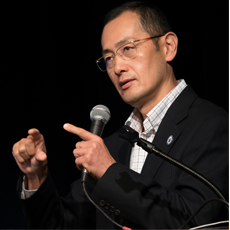Science News
Neighboring Nobel Winner
December 11, 2012

How do you get from bad cholesterol to liver cancer to stem cells to a Nobel Prize? According to San Francisco’s Gladstone Institutes, you follow the science.
At least that’s how it worked for Shinya Yamanaka, a Japanese scientist and senior investigator at Gladstone. Yesterday in a ceremony in Norway, he was awarded the Nobel Prize in Physiology or Medicine for his discovery of how to transform ordinary adult skin cells into cells that, like embryonic stem cells, are capable of developing into any cell in the human body.
“Cells that can develop into any cell in the human body can be used to replace specific damaged tissues, such as those involved in blindness and spinal cord injuries, and treat a whole range of diseases, from cancer to immune disorders to neurodegenerative disorders,” says the Academy’s Shannon Bennett. “The growing field of regenerative medicine depends on using these pluripotent cells—cells that can become almost anything.
“Up to now getting these cells has raised ethical concerns, because they are collected from fertilized human embryos which are destroyed by the process. Adult stem cells are not as useful an alternative—they are already committed to the organ they come from. But now, Yamanaka has discovered a method to induce adult cells that have already developed—skin cells, for example—to become pluripotent, cells that can become virtually any cell in the human body!”
Yamanaka’s path to the Nobel Prize wasn’t as neat as you might think. He started his science career as a surgeon, “only to find he was not so good at it,” according to the New York Times.
He came to Gladstone in 1993 and worked with mice to research how to lower bad cholesterol. A hopeful treatment caused liver cancer in the mice, which led Yamanaka to research the cancer.
He needed stem cells to research the cancer in the mice and eventually the stem cells became his focus.
Which led him to his Nobel Prize-winning research.
Science often works this way—unexpected discoveries lead to new paths and questions. And Gladstone especially seems to embrace and understand this. From their website:
“The Gladstone philosophy has always been to allow scientists like Shinya Yamanaka the freedom to follow wherever their curiosity—and the science—leads,” says Robert Mahley, MD, PhD, Gladstone's founding scientist... “As a postdoc, Dr. Yamanaka embraced that philosophy, which I think has played a big part in making him the scientist and the person he is today.”
Please stay tuned: the Academy and Gladstone will kick off a week-long festival in January 2013 called Brilliant!Science: Decoding Human Health—including lectures, events, family activities and opportunities to engage with active scientists.
“The Brilliant!Science festival will be a great collaboration and help demonstrate the synergies amongst all kinds of research, from human health to biodiversity,” says Shannon. “Whether its about the diversity of cells in the human body, the genes that compose us, the diseases that plague us, or the diversity of life forms around us, science unfolds in a similar pattern—with questions! We’ll share a week of exciting science from both Academy and Gladstone scientists, hosted around the city and at the Academy itself.”
Image: Gladstone Institutes/Chris Goodfellow